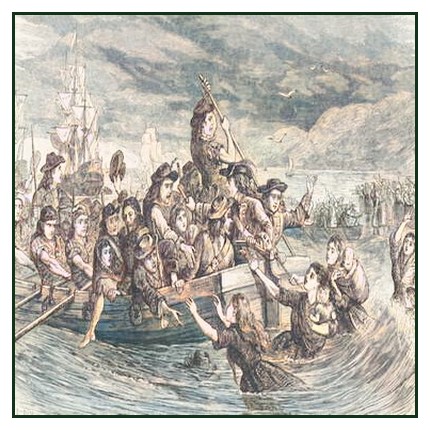
Ireland – In a remarkable retelling of a pivotal period in Irish history, Thomas Pheasant invites readers on a journey through the events of 1691 when the Flight of the Wild Geese unfolded. This tumultuous period was marked by significant military campaigns, betrayals, and the subsequent emigration of Irish soldiers to foreign lands.
As the year 1691 began, the Williamite forces initiated a campaign that would shape the destiny of Ireland. Led by General Ginkle, an army of 40,000 troops embarked on a westward march, eventually besieging Ballymore. In a valiant defence, Colonel Ulick Burke and his garrison fought resolutely. However, despite their brave efforts, they were ultimately outnumbered and compelled to surrender when a breach was made in the town’s defences.
Following the capture of Ballymore, the Williamite forces advanced on Athlone, initiating a siege that would culminate in their entry into the English town on the Leinster side of the Shannon River on June 29th. During these trying times, Irish commanders Tyrconnell and Sarsfield advocated for a strategic withdrawal and the destruction of the fortifications of the Irish town on the Connacht side of the river. This approach would have allowed them to oppose the English forces more effectively. However, their counsel was rebuffed by General St. Ruth, who opted to proceed with the bombardment of the Irish town.

Subsequently, De Ginkle, the Williamite commander, led his troops across the Shannon River, catching the Irish off-guard. A series of battles ensued, with the Irish infantry demonstrating great valour and pushing the English forces back multiple times. The tide of the battle seemed to favor the Irish until a tragic turn of events.
In a pivotal moment, General St. Ruth was struck by a cannonball and lost his life on the battlefield. With their commander fallen, confusion began to spread among the Irish forces. Sarsfield, who was positioned far from the action due to St. Ruth’s orders, was unaware of the dire situation.
The death of St. Ruth marked a turning point in the battle. The Irish infantry, lacking cavalry support, faced relentless attacks from English horsemen, leading to their ultimate defeat. The English cavalry, under De Ginkle’s command, seized the opportunity to assault the disordered Irish ranks.
The Castle of Aughrim, strategically positioned at the head of a causeway and surrounded by treacherous bogs, played a crucial role in protecting the English forces’ front. A fatal error or, perhaps, treachery occurred when Colonel Walter Burke, tasked with defending the causeway, received supplies that contained cannonballs filled with musket bullets instead of proper ammunition.
The English artillery and cavalry made their way through the causeway, while the infantry crossed the bogs unharmed. By early afternoon, the English forces were arrayed for battle, facing the Irish lines on Kilcommedan hill.
The battle raged with ferocity, with the Irish infantry displaying great bravery and repeatedly repelling the English forces. At one point, General St. Ruth passionately declared that they would chase the English forces to the gates of Dublin. However, these would be his final words, as he was struck down by a cannonball.
With the loss of their commander, the Irish forces fell into disarray, and the English cavalry capitalized on the situation, attacking the vulnerable infantry. Sarsfield, who had been too distant to grasp the evolving crisis, could not intervene effectively.
The Irish infantry, devoid of cavalry support, found themselves at the mercy of the English horsemen, leading to their ultimate defeat. Only Sarsfield’s cavalry, positioned by St. Ruth’s orders away from the main battle, was able to cover the retreat of the retreating Irish forces.
The battle exacted a heavy toll on the Irish troops, with many valiant soldiers perishing in the tumultuous retreat. Notably, the King’s Regiment of Cavalry, Queen’s Regiment of Cavalry, King’s Royal Dragoons (Sarsfield’s), Lucas’s Dragoons (Patrick Sarsfield’s), Clare’s Dragoons (Charles O’Brien’s), and other renowned regiments played vital roles in the battle.
The Battle of Aughrim left an indelible mark on Irish history, with the loss of many brave souls. The departure of General Sarsfield and other Irish chieftains marked the Flight of the Wild Geese, as they left their homeland to serve abroad under French colors. It was a time of profound change for Ireland, and the sacrifices made by these valiant soldiers would be remembered through the centuries.
Despite the challenges and trials faced by the Irish people during this tumultuous period, their unwavering faith and resilience endured. The legacy of their struggle lives on, and the Flight of the Wild Geese remains a significant chapter in Irish history.
Thomas Pheasant vividly recounts the events of 1691, focusing on the Battle of Aughrim and the subsequent Flight of the Wild Geese. The battle, marked by valiant Irish resistance and tragic losses, ultimately led to the departure of Irish soldiers to serve abroad under French colors. Despite the challenges faced during this period, the Irish people’s enduring faith and resilience continue to shape their rich history. This narratives provide a glimpse into the cultural and historical fabric of Ireland, where tradition and heritage intersect with stories of bravery and determination.
Drogheda Independent – Saturday 18 August 1906


